City of Baths: The Best Thermal Baths in Budapest
January 28th, 2022
While many come to Budapest to experience the ruin bars or majestic castles, it would be a shame to overlook one of the most integral parts of the city: the thermal baths. Budapest sits on a patchwork of thermal and mineral waterways comprised of more than 1000 springs, resulting in many a bathhouse - giving travelers a chance to take a break and relax.
From 16th century Turkish baths to splendid 19th century buildings, visiting Budapest's thermal baths are a way to experience history (and maybe even get a massage at the same time!). Here's what you need to know about thermal baths in Budapest!
City Center
Széchenyi Baths

-
Date: 1913, expanded in 1927 and 1960
-
Architectural style: Neo-baroque and modern-renaissance elements
-
Number of pools: 21
-
Temperature range of pools 18-40˚ C (64.4-104˚ F)
-
Number of saunas / steam rooms: 9
-
Extra services: medical treatments, massages, manicure, pedicure, Thermal Beer Spa, restaurant
-
Day ticket prices: 7100-7600 HUF / € 18-20
The yellow arcades of Széchenyi Bath are perhaps the most iconic of Budapest. Széchenyi Bath is the largest thermal bath complex in Budapest with 21 pools, from which 5 pools are outdoors and 16 are indoors.
Cooling and immersion pools range between 18-20˚ C, while thermal pools vary between 28-40˚ C.
The water is rich in calcium, magnesium, and hydro-carbonate and contains sodium, sulfate, fluoride, and metaboric acid. These components assist in treating joint diseases, arthritis, and helping in many post-accident and orthopedic treatments.
The spring which supplies the water here is 76˚ C, so it needs to be cooled down before it enters the pools. If you walk around the building even on the hottest summer day you can see the steam rising from the drains.
The bathhouse offers traditional medical treatments, as well as beauty treatments and massages. On top of all this Szechenyi Bath is the home of the Thermal Beer Spa during regular opening hours and the world-famous bath party, Sparty, on Saturday nights.
Palatinus Bath
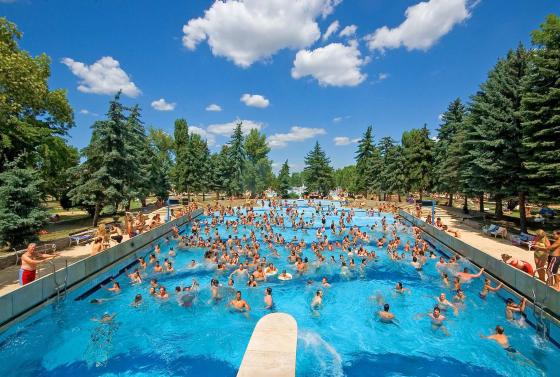
-
Date: 1919 beach, 1921 pool, expanded 1937
-
Architectural style: Contemporary
-
Number of pools: 14 (4 indoor, 10 outdoor)
-
Temperature range of pools 26-42˚ C (78.8-107.6˚ F)
-
Number of saunas / steam rooms: 3
-
Extra services: sports and outdoor fitness grounds, playgrounds, slides, outdoor restaurants and bars, massages, beach product shops
-
Day ticket prices: 3600-4000 HUF
The Palatinus Bath is located in Margaret Island, in a nature reserve of more than 75,000 square meters. The bath was originally opened as an open-air beach on the Danube bank in 1919 and only got its first pool in 1921.
The popularity of the bath grew quickly and so it was expanded in 1937. At first, it was only open for the summer season as all pools were located outside. But since the opening of the recently constructed indoor thermal section, the bathhouse is open all year round.
The thermal water, supplied by springs from Margaret Island and used in 4 pools throughout the complex, contains calcium, magnesium, hydrogen carbonate, and sodium. The indoor pools range between 14˚ and 42˚ C, while the outside pools run between 26-36˚ C.
As the outdoor section was built more for recreational purposes rather than for healing, you can have fun in many pools like the wave pool, slide pool, adventure pool, and leisure pool, while there are kid pools waiting for the little ones both indoors and outdoors.
You can easily spend your entire day at Palatinus as it offers more than just an amazing range of pools.The 75,000 square meter area has sports fields, outdoor fitness equipment, plenty of space for sunbathing and relaxing, and a range of restaurants where you can enjoy ice-cold drinks, ice cream and much more.
Rudas Bath
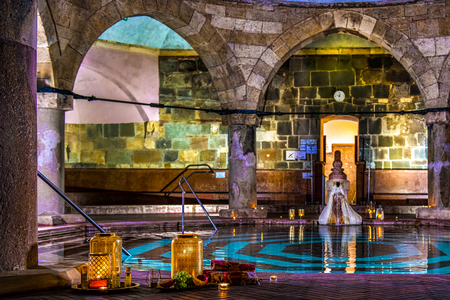
-
Date: Built in 1550, expanded many times from the 18th century to 2014
-
Architectural style: Ottoman with contemporary elements
-
Number of pools: 12
-
Temperature range of pools: 16-42˚ C (60.8-107.6˚ F)
-
Number of saunas / steam rooms: 3
-
Extra services: Massages, Restaurant and bar, Friday and Saturday night bathing 10 pm-4 am
-
Day ticket prices: 6500 - 8500 HUF
The Rudas Bath is surrounded by 21 thermal springs. Rudas has a far reaching history: The bathhouse was first built by the Ottomans in 1550 and then later expanded with the swimming pool and saunas in 1896. T
he building was severely damaged in WWII, but luckily the original Turkish bath survived completely.
After the ruined parts of the building were rebuilt, the bath reopened in 1953. The latest large-scale renovation was completed in 2014 when the complex was expanded with the wellness section.
The bath uses slightly radioactive hot spring water with calcium-magnesium-hydrogen-carbonate also containing sodium and sulfate and with a significant content of fluoride ions.
This water is suggested as a means of therapy for degenerative joint diseases, arthritis, discus hernia, and for stabbing, burning, and often severe pain due to irritated or damaged nerves.
The bath has three sections: thermal, swimming, and wellness. The thermal section has 6 indoor pools ranging between 16-42˚ C. The swimming pool section contains only one 29˚ C pool, while the wellness section has 4 hot pools (32-42˚ C) and one cold water immersion pool.
One of the wellness section's hot water pools is located on the top of the building, offering a spectacular view over the Danube. The bath features two 42˚ C pools, which are the hottest thermal water pools you can find in Budapest.
It's important to note that there are SEPARATE days for men and women during the week, but it is open for everyone over the weekend.
Additionally, there are 3 sections in the bathhouse, but not every type of ticket gives you access to all parts of the bath, so read the ticket types carefully before purchasing!
Gellért Baths
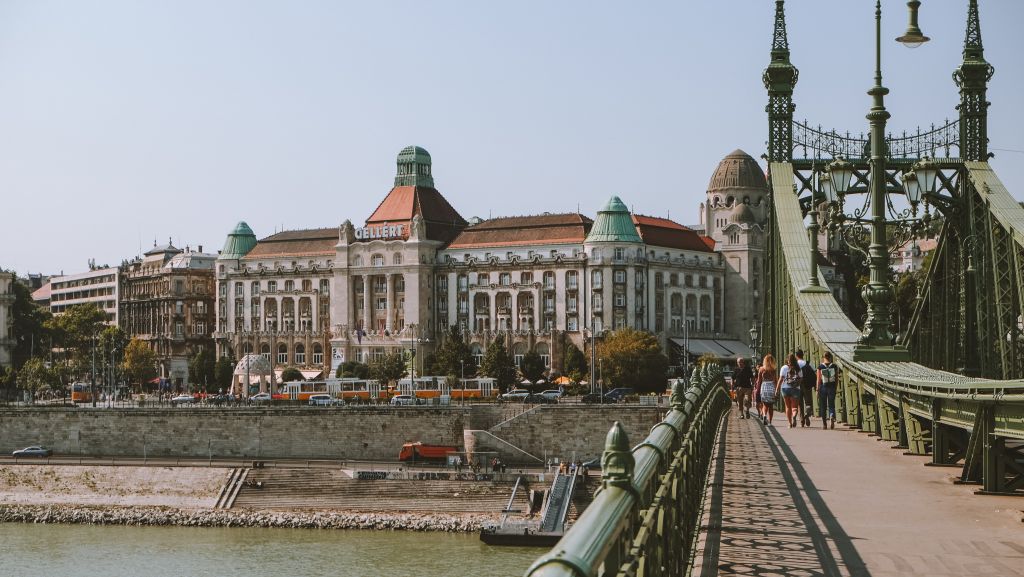
-
Date: 1918
-
Architectural style: Art Nouveau with Hungarian national elements
-
Number of pools: 10
-
Temperature range of pools: 19-40˚ C (66.2-104˚ F)
-
Number of saunas / steam rooms: 5
-
Extra services: Prescribed medical services, Beauty salon, pedicure, solarium, massage, restaurant
-
Day ticket prices: 7100-7600 HUF / € 18-20.00
The "miraculous" springs on the territory of the Gellért Bath were known as early as the 15th century. Under the Ottoman rule they were popular because they were larger and hotter than the already functioning bathhouses.
In the 17th century, the bath was called the “Mud Bath” because of the fine sediment that came up with the thermal water and settled at the bottom of the pools.
The Gellért Thermal Bath and Hotel was built in 1918 and was expanded in 1927 and again in 1934. The artificial wave pool, a rarity at the time, was built in 1927 and is still working to this day.
The water supply to the baths springs from Gellért Hill. The water is thermal spring water with calcium, magnesium, hydrogen-carbonate, sulfate-chloride, and also contains sodium and fluoride ions.
It is suggested as a means of therapy for joint diseases, spinal deformity, arthritis, discus hernia and many more.
Inside the building we can find 8 pools from which one is a swimming pool (26˚ C), two are immersion pools of (19˚ C) and the remainder are thermal pools (ranging between 35-40˚ C). Outdoors we can enjoy the previously mentioned wave pool and a thermal pool measuring 36˚ C.
Lukács Thermal Bath

-
Date: 1979
-
Architectural style: neo-classical with old Moorish elements
-
Number of pools: 10
-
Temperature range of pools: 19-40˚ C (66.2-104˚ F)
-
Number of saunas / steam rooms: 4 + 5 more in Sauna World
-
Extra services: medical treatments, massages, Sauna World
-
Day ticket prices: 3800-4200 HUF / € 10-12
Thermal baths have been used for healing at this location by the Knights of the Order of Saint John since at least the 12th century.
In the Ottoman period, the hot spring water was the source of the power at the so-called Csaszar Mill, which produced gunpowder and ground wheat. You can still see the parts of the mill's wall in the interior of the bathhouse.
The St. Lukács spa hotel was built in 1880, expanded with the therapeutic drinking hall in 1937, and further expanded with the complex thermal bathing facilities (daytime hospital) in 1979.
The water of the bath contains calcium, magnesium, hydrogen-carbonate and sulfate, chloride, sodium, and a substantial content of fluoride ions. This water is suggested as a means of therapy for joint diseases, arthritis, spinal deformity, hernia and post-accident rehabilitation.
Outdoors you can find 2 swimming pools and 1 thermal leisure pool (33-35˚ C). Indoors you can enjoy 3 thermal pools ranging between 32-40˚ C, saunas, and the plunge pools.
With the basic day ticket you get access to 4 saunas / steam rooms, but if you enjoy the saunas you might want to consider upgrading to the Sauna World ticket which includes 5 additional ones.
Veli Bej / Csaszar Bath
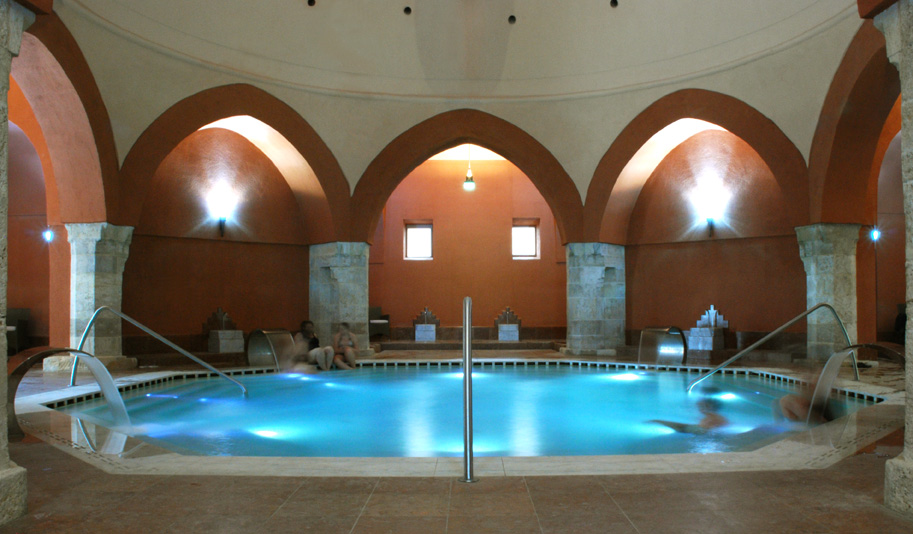
-
Date: 16th century
-
Architectural style: Ottoman with Classicist-style extensions
-
Number of pools: 7
-
Temperature range of pools: 26-38˚ C (78.8-100.4˚ F)
-
Number of saunas / steam rooms: 4
-
Extra services: Cafe, beauty salon, massage
-
Day ticket prices: 2800 - 3500 HUF / € 8-9.70
The thermal waters of the area were known as early as the Roman times, and they were used for healing before the bath was built. The building was erected by the Ottomans in the 16th century and was, according to sources at the time, one of the most beautiful bathhouses.
After the Turkish occupation it was given to the order of Hospitallers, who used it for healing the sick and it has been used for healing ever since. The building was closed to the public for a time but after recent renovations it's finally open for everyone.
The waters of the bathhouse are supplied by the springs of Luke's Bath and from Margaret Island. The waters are rich in calcium, magnesium, hydrogen-carbonate, sulfate, and sodium, with a significant content of fluoride ions.
It is recommended for degenerative illnesses of joints, arthritis, spinal problems, and post-injury healing. The traditional Turkish bath contains 5 thermal pools, ranging from 36-38˚ C, and in the new parts of the building you can enjoy a swimming pool and a jacuzzi too.
This is now likely one of the nicest but lesser-known thermal baths in Budapest. If you would like to relax and avoid crowds come here in the evening hours (and enjoy the discounted evening ticket price too).
Király Baths (temporarily closed)
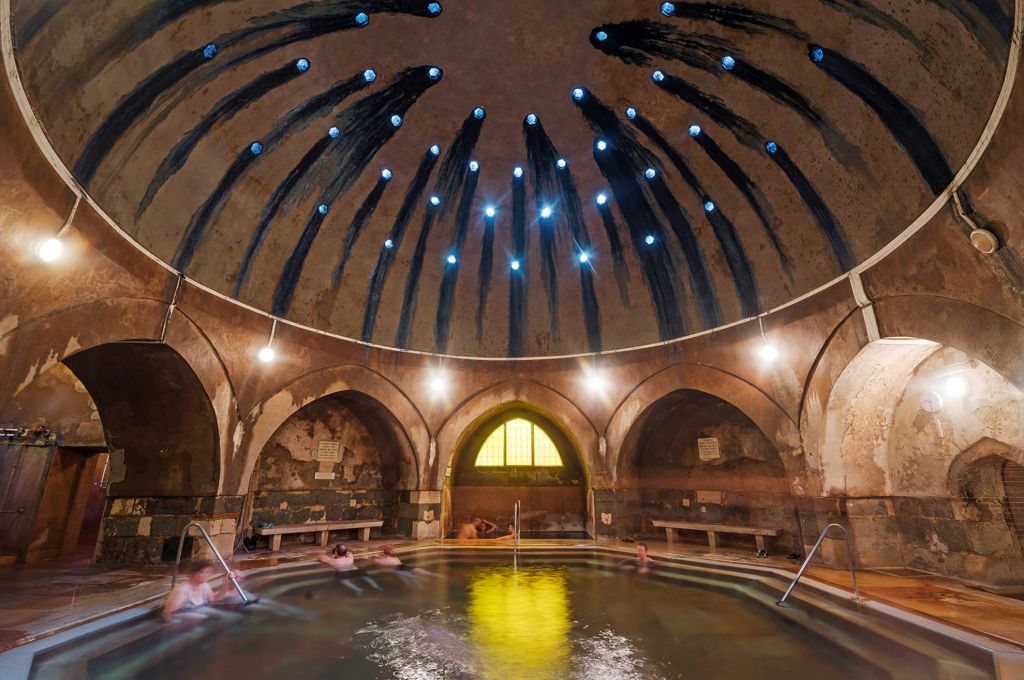
-
Date: 1565, renovated to its current form in 1796
-
Architectural style: Ottoman
-
Number of pools: 6
-
Temperature range of pools: 26-40˚ C (78.8-104˚ F)
-
Number of saunas / steam rooms: 2
-
Extra services: Sunbathing garden, massages
-
Day ticket prices: 2700-3300 HUF / € 7.50-9.00
The Király Bath was built in 1565 by the Ottomans, serving a special purpose: up until this point no bathhouse was built inside the protective city walls and the Ottomans were afraid that they would not be able to get to the thermal baths outside if the city was under a siege.
There is no spring directly in the area so they pumped the water all the way from the spring by the previously mentioned Lukacs bath, from where the building still receives its water to this day.
After the end of the Ottoman rule the bath became the property of the Konig (King) family, from where the name of the bath originates.
The hot spring water contains calcium, magnesium, hydrogen-carbonate and sulfate, sodium, and a substantial amount of fluoride ions. It's suggested as a means of therapy for degenerative joint diseases, arthritis, discus hernia, spinal deformity, neuralgia, and for post-accident rehabilitation.
You can enjoy the benefits of this water in 3 indoor thermal pools, 1 immersion pool, a jacuzzi, and 1 outdoor wooden hot tub. The hot pools range between 32-40˚ C.
Outside the City Center
If you would like to venture out of the tourist city center, Budapest offers many newly built or recently expanded thermal baths that are frequented mostly by locals. Visit these during the daytime on weekdays when Hungarians are working for a more private experience.
Csillaghegy Árpád Bath

-
Date: 2000 & 2018
-
Architectural style: Contemporary
-
Number of pools: 15
-
Temperature range of pools: 22-42˚ C (71.6-107.6˚ F)
-
Number of saunas / steam rooms: 5
-
Extra services: massages, free parking lot, Aqua Stella Bistro, Slides
-
Day ticket prices: 4100 - 4400 HUF / € 10-11
During the second half of the 19th century the area of this bath complex was home to one of the oldest open-air baths in Budapest and was slowly expanded throughout the 20th century.
The outdoor pools went through a series of renovations and have been operating in their present form since 2000. The building, with 12 indoor pools, is brand new, having only opened its gates in 2018.
An interesting fact about the newest construction is that in 2017, while digging out the pools, two Roman age graves (one Celtic and one Roman) were found here. Artefacts from similar discoveries are visible in the nearby Aquincum museum and further archaeological digs are in process.
The outdoor pools are surrounded by over 90,000 square meters of gardens, where in the summertime you can enjoy outdoor fitness equipment, playgrounds, and sunbathing areas. The three outdoor pools are only 22-23˚ C, so they are only operational in the summer months.
However, if you are visiting in the winter don't be upset! There are 12 other pools and countless saunas waiting for you indoors, so you will definitely not be bored for a second. The indoor water temperature ranges between 22-42˚ C and the indoors area features a couple of specialty pools like the rooftop panorama pool (which is outdoors on the terrace of the Sauna World, but still operates in winter) and the saltwater pool.
One of the coolest features of the building are the slides that leave the building from the 5th floor and continue outside. One of them ends in the outdoor pool, while the other ends in a pool on the 3rd floor.
The water used by the building is natural mineral water with calcium, magnesium and hydrogen-carbonate.
Pesterzsebeti Iodine & Thermal Bath
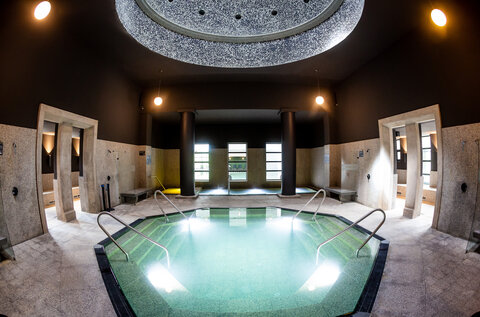
-
Date: 1930, fully redone in 2018
-
Architectural style: contemporary, with one “fake” Turkish style bath
-
Number of pools: 14
-
Temperature range of pools: 10-42˚ C (50-107.6˚ F)
-
Extra services: massages, children pools
-
Day ticket prices: 3900 - 4100 HUF / € 9-10
The Pesterzsebeti Bath, built in 1930, first used water from the nearby Danube. However, in 1931 the search began for other water sources, which resulted in finding a thermal water source unique in Budapest: one with significant amounts of iodine, salt and bromine. In 1936 a Turkish style bath was built here with a small hotel.
Unfortunately, the building was severely damaged during WWII, and even after renovation suffered from other problems such as insufficient water flow from the wells. In 1956 the bath was renovated and new wells were drilled.
The bath was expanded throughout the 1970s, but due to the high operating costs the outdoor section was closed in 2001, followed by the thermal bath in 2005. The bath, as well as the outdoor pool complex,
As we mentioned earlier, the water is really special here. This Budapest thermal bath complex uses two kinds of thermal water. One of the varieties is comprised of sodium, calcium, magnesium, hydro-carbonate, sulfate, and a significant amount of salt, idoine, and bromide. The other is the iodine-salt source: sodium chloride with a significant content in bromide, iodine and iron.
This special type of water is great for the treatment of musculoskeletal diseases and gynecological complaints. The iodine is anti-inflammatory, antiseptic, and well-known for its benefits in circulation, while bromide has abilities to calm the nervous system. So if you need to relieve some stress, this is the best place for you!
You can enjoy all of these benefits in 4 indoor pools as well as one more outside. In addition to the thermal water pools, Pesterzsebeti Bath features 9 more pools including an outdoor wave pool and an indoor leisure pool.
The water ranges between 10-42˚ C inside and 26-38˚ C outdoors.
Pascal
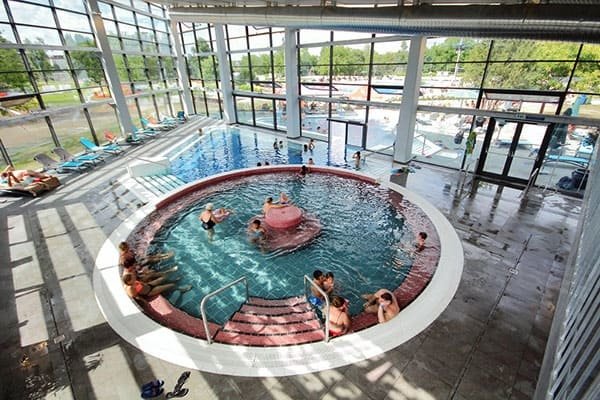
-
Date: 1989
-
Architectural style: Contemporary
-
Number of pools: 10
-
Temperature range of pools: 16-42˚ C (60.8-107.6˚ F)
-
Number of saunas / steam rooms: 4
-
Extra services: Family-friendly areas, massages, Aqua Bar, Paskal Drink Bar
-
Day ticket prices: 3200 - 3500 HUF / € 8-9
Paskal Bath is the “youngest” Thermal Bath of Budapest, as it was only established in 1989. The main building of the bathhouse was recently renovated and in 2016 a new, covered section and saunas were added to the complex. Its newest addition, an outdoor pool, was just built in 2018.
The most special feature of this bath is its Aqua Bar, where you can purchase drinks, which we can find in the outside end of the leisure pool. In the winter months the Aqua Bar is not open, but this leisure pool still offers you something special. In many bathhouses, you need to leave the indoor pools to get to the outside ones, which is quite chilly to do in winter. But here you can simply swim out in the 36˚ C water and watch the steam rise around you while you are still nice and warm.
The water supply of the bath is quite special too. It's 70˚ C spring water with calcium, magnesium, hydrogen-carbonate, and chloride. It also contains sodium and a substantial amount of fluoride ions, which obviously gets cooled before entering the pools.
The 6 indoor pools range between 16-42˚ C while the outdoor ones vary between 26-36˚ C.
Dandár
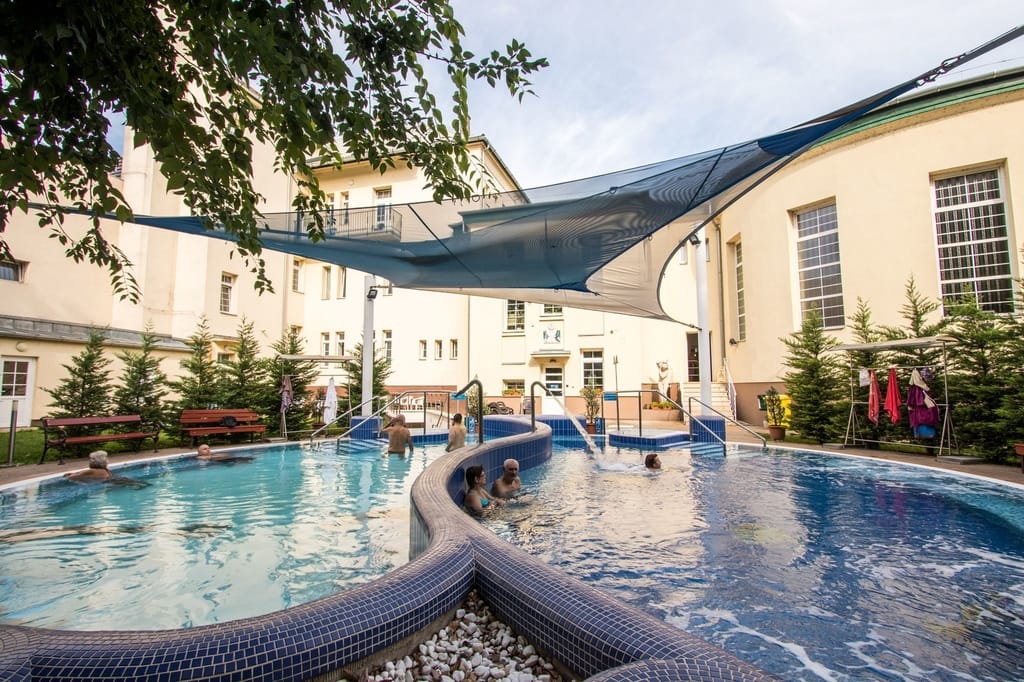
-
Date: 1930
-
Architectural style: Expressionist style
-
Number of pools: 5
-
Temperature range of pools: 20-38˚ C (68-100.4˚ F)
-
Number of saunas / steam rooms: 2
-
Extra services: sun deck, massage, pedicure
-
Day ticket prices: 3100 - 3200 HUF / € 7-8
At the beginning of the 20th century not every apartment had bathrooms, so the Dandár Bath was commissioned to be built as a “sanitary bath”. The bathhouse opened its gates to the public with 15 adult bath tubs and 15 for children.
The bathhouse was only slightly damaged in the Second World War and was functioning again as soon as 1945. As the public sanitary bath function was no longer needed, the bath was transformed in 1978 to a thermal bath.
The building went through many reconstructions and expansions since. In 2014, two outdoor pools (36˚ and 38˚ C) and a Sauna World section were added. In 2015 the wellness section was completely renovated.
The thermal water contains calcium, magnesium, hydrogen-carbonate, sulfate-chloride, and sodium. It is used in the therapeutic treatment of problems like joint diseases, arthritis, hernia, and neuralgia.
Enjoy the thermal water in 2 outdoor pools (36˚ and 38˚C) and 3 more indoor pools (20˚, 36˚, and 38˚ C).
When you are fully relaxed and have left the stress of the previous days behind, don't forget to visit the Unicum Museum across the road to see where the world-famous Hungaraian spirit is made.
Every spa on this list offers you something unique! Our capital city has more medicinal spas than any other European country, so you can't leave without visiting at least one of Budapest's thermal baths.
We hope this article helps you compare the features of Budapest's thermal baths and you are now ready to choose the right one for your needs. Believe us, after a long trip there is nothing better for aching muscles and joints - or for a hangover - than relaxing in healing thermal water for a couple of hours. Enjoy!
Related Articles


